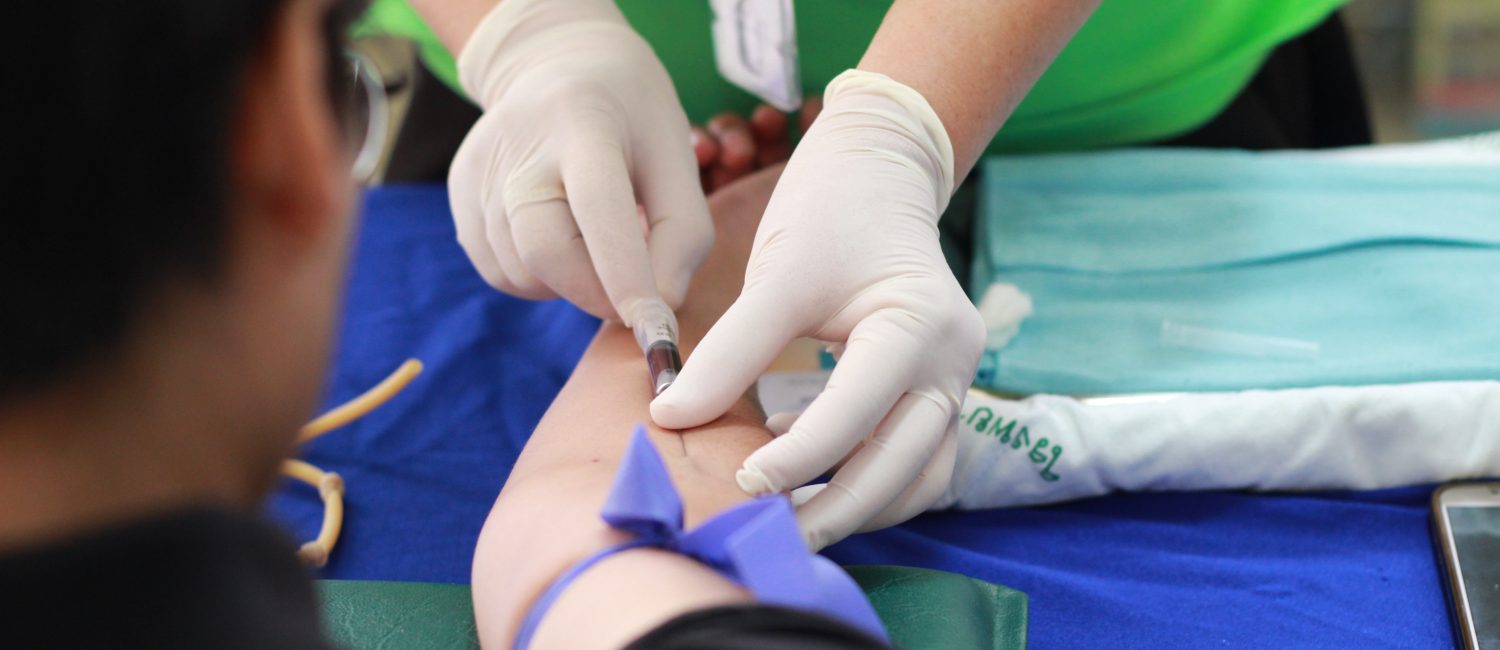Public Health Issues
Throughout the years, Community Health Services has been driven by the health needs of our community. Cancer, obesity, heart disease, diabetes, sexually transmitted diseases, tuberculosis, many other communicable diseases, lead poisoning, rabies exposure and many others, are all serious issues that are negatively impacting the health of Genesee and Orleans County residents.
Community Health Services care for all the people within our community by monitoring the spread of disease, watching for environmental hazards, educating the community, and training for community disasters.
The Health Department offers an array of Public Health Clinics and Services to Genesee and Orleans County residents including Childhood and Adult Immunizations, Tuberculosis Screening and Treatment, confidential Sexually Transmitted Disease referral and counseling, anonymous and confidential AIDS/HIV counseling and testing. Services may be covered by insurance or you may be eligible for free care.
Need Naloxone? Text KIT to 877-535-2461
Linkage to Care App- Online App that helps citizens connect with support centers for opioid rehabilitation and training in Genesee, Orleans, and Wyoming Counties. The app provides links to 24-hour assistance call lines, detox services, the PAARI (Public Safety Assisted Addiction and Recovery Initiative) program, Naloxone (Narcan) training, self-help meetings, medication, and sharps drop box locations, as well as inpatient and outpatient services in the three counties.
PAARI Locations: Here are the Public Safety Assisted Addiction Recovery Initiative (PAARI) locations in Genesee County available 24/7 for substance use support and referral:
City of Batavia Fire
18 Evans St, Batavia
(585) 345-6375
City of Batavia Police
10 West Main St, Batavia
(585) 345-6350
Genesee County Sheriff
165 Park Rd, Batavia
(585) 345-3000
LeRoy Police Department
3 West Main St, LeRoy
(585) 768-2527
UConnectCare Peer Hotline – (585) 815-1800
Did you know that more than 140,000 people die from excessive alcohol use in the United States each year? This is more than 380 deaths each day.
Check your alcohol use by using a screening tool from the CDC. Click Here!
Asthma is one of the most common chronic diseases with an estimated 300 million individuals affected worldwide. Its prevalence is increasing, especially among children. Asthma can be effectively treated, and most patients can keep their asthma under control. Asthma is a chronic inflammatory disease of the airways. Chronically inflamed airways are hyper-responsive and become obstructed limiting airflow (by mucus plugs and inflammation) when airways are exposed to risk factors.
Common risk factors for asthma symptoms are allergens: dust mites, animals with fur like cats and dogs, pollens and mold; occupational irritants; respiratory viral infections; tobacco smoke; exercise; and drugs, such as aspirin and beta-blockers.
To learn more about asthma visit the following websites:
New York State Department of Health (NYSDOH)
For more information, call the Genesee County Health Department at (585) 344-2580 ext. 5555
There are over one hundred different types of cancer. Most cancers are named after the body part or cell where abnormal growth begins. For example, cancer that originates in the lungs is called lung cancer. The most common cancers found in men, besides skin cancer, are prostate, lung, and colon cancer. Breast, lung, and colon cancers are the most common cancers found in women. Check the following resources for more information:
The World Health Organization defines Communicable Diseases as, “Infectious diseases are caused by pathogenic microorganisms, such as bacteria, viruses, parasites or fungi; the diseases can be spread, directly or indirectly, from one person to another. Zoonotic diseases are infectious diseases of animals that can cause disease when transmitted to humans. ”
Communicable Disease = Infectious Disease = Transmissible Disease = Contagious Disease
The GO Health Departments are responsible for the timely surveillance, investigation, reporting, and control of communicable diseases within the community. Do your part to stop the spread of communicable diseases – begin by always washing your hands properly.
For more information about Communicable Diseases:
Almost one-third of New Yorkers are in danger of developing diabetes as adults, and the risk greatly increases as a person gets older, according to a recent statewide Behavioral Risk Factor Surveillance System (BRFSS) survey.
Diabetes is a disease that affects the body’s ability to produce or use insulin, a hormone that allows the cells to turn sugar into energy. Symptoms of diabetes include frequent and excessive urination, excessive thirst, and weight loss despite increased appetite. People with diabetes may also experience occasional blurred vision; unusual tiredness or drowsiness; frequent or recurring skin, gum, or bladder infections; and tingling or numbness in the hands or feet.
People who are at greater risk of developing diabetes are those who are overweight; physically inactive; have a parent, brother, or sister who has diabetes; or have high blood pressure or abnormal blood cholesterol levels. Hispanics, African-Americans, and Native Americans have a greater risk than others of developing diabetes.
The Diabetes Prevention Program (also known as Prevent T2) is a proven evidence-based lifestyle program for preventing type 2 diabetes. For sixteen weeks, participants meet with a lifestyle coach and a small group of people who are making lifestyle changes to prevent diabetes. DPP helps participants make achievable and realistic lasting changes such as eating healthier, including physical activity into their daily lives, and improving problem-solving and coping skills. The program is for adults who have been diagnosed with pre-diabetes or are at risk of pre-diabetes and can cut your risk of developing type 2 diabetes by 58%. For more information contact [email protected].
To learn more about Diabetes and Diabetes Prevention:
Dental Health
Over the past 50 years, the citizens of New York State have seen a dramatic improvement in their oral health. Still, oral diseases are a major health concern that affect almost every person in New York State. Oral health and general health are inseparable. Diseases and conditions of the mouth have a direct impact on the health of the entire body. Good oral health can help improve birth outcomes, keep children from developing painful cavities and prevent seniors and those with chronic health conditions from developing life-threatening complications. Oral Health Resources:
Community Water Fluoridation
Community Water Fluoridation is the process of optimizing fluoride levels in drinking water to prevent cavities. This public health measure benefits the entire community by promoting oral health, reducing disparities, and lowering dental care costs. For more information on community water fluoridation, visit the CDC.
Communities Benefit from Water Fluoridation Infographic
New York State Department of Health: Fluoride is Nature’s Way to Fight Tooth Decay
Cardiovascular disease (CVD) refers to several types of disease that involve the heart and blood vessels. CVD includes coronary heart disease (CHD), stroke, heart failure, and other conditions affecting the heart and blood vessels.
Heart Disease is a term that refers to several types of heart conditions which include CHD, valves in the heart, and congestive heart failure. The most common type of heart disease is CHD. CHD occurs when a substance called plaque builds up that narrows the arteries in the heart. A heart attack occurs when an artery becomes completely blocked, resulting in a lack of blood flow to the heart. Heart disease is the leading cause of death for both men and women in the United States and in New York State. To learn more about heart disease and what you can do to reduce your risk, visit the Centers for Disease Control and Prevention (CDC).
A stroke, also referred to as a brain attack, occurs when the blood supply to the brain is blocked or a blood vessel in the brain bursts. Stroke is the fourth and fifth leading cause of death in New York State and the U.S., respectively, and a cause of significant disability. To learn more about strokes and what you can do to reduce your risk for a stroke, visit the American Stroke Association. To learn what New York State is doing to prevent strokes and improve care for New Yorkers who have had a stroke, visit the NYS Coverdell Stroke Quality Improvement and Registry Program.
For more information about Heart Disease and Stroke Prevention:
A visit to your health care provider can resolve many health concerns. But, if communication is poor, you may walk away feeling confused and frustrated. In today’s health care environment, preparation and communication are more important than ever. Dissatisfaction often means the patient did not discuss what was most troubling, or his or her questions were never answered. Although health care providers work hard to give top quality health care, they may not anticipate or recognize the concerns a patient may have. At the same time, patients’ feelings may prevent them from asking questions.
For example, some patients are hesitant to talk about sensitive health topics such as: urinary incontinence, prostate problems, sexual dysfunction, sexually transmitted diseases, or gynecological problems. Others may not think their symptoms are important; or they may be afraid of wasting the provider’s time; of hearing bad news, or learning about treatment options.
Take the following simple, but effective steps to prepare for a visit to your health care provider:
- Learn as much as you can about your condition.
- Develop and bring with you a list of your symptoms; questions; including any you may think are silly, embarrassing or unimportant; and your family’s medical history. This history, along with a physical examination, is extremely helpful in making a diagnosis.
- Bring all of your medications.
During your visit, ask:
- What are the most likely reasons for my problem(s)? What test(s) do you advise? What are the risks?
- What is the prognosis? That is, will it go away by itself? How long will it last? What are the pros and cons of treatment, or no treatment at all?
- What can be done to prevent complications or recurrences?
- At the end of your visit, review your questions and be sure all of your concerns have been addressed. If they have not, insist that your health care provider provide more information.
HIV does not discriminate, have you been tested?
In the United States, HIV is spread mainly through anal or vaginal sex or by sharing drug-use equipment with an infected person. HIV is found in specific human body fluids, such as, blood semen, pre-seminal fluid, breast milk, vaginal fluids and anal mucous. If any of those fluids enter your body, you can become infected with HIV. The Genesee County Health Department works together with the New York State Department of Health advocating to reduce the spread of HIV in our community.
Reduce your risk…
-
- Don’t have sex
- Be monogamous
- Get Tested and know your partner’s status
- Use condoms consistently and correctly
- Do not share syringes or needles
Additional Resources:
CDC Guidance
NYSDOH Guidance
DEC: Household Sharps – Dispose of them Safely
Why Immunize?
Immunization is one of the most important things you can do to protect your children. Getting all of their recommended shots on time gives them the best protection from serious and sometimes deadly diseases.
Every year babies and children still get sick and die from illnesses that vaccines could have prevented such as the flu, measles, meningitis, and whooping cough. Vaccinations help make a child’s immune system strong so they can fight disease.
Unfortunately, this year because of the COVID-19 pandemic, many families have postponed vaccination and well-child visits while following guidance to stay home. But these visits are essential services and your health care provider has taken all necessary steps to ensure your family’s safety while visiting their office.
Make an appointment to catch up on any missed vaccinations as soon as possible. Children who are not protected by vaccines may be more likely to get diseases like measles and whooping cough.
Immunizations are NOT just for children! Adults of all ages need immunizations to keep us healthy. The specific vaccines recommended for adults may depend on factors such as age, health conditions, lifestyle and risk factors, and travel plans.
New York State Immunization Requirements for School Entrance / Attendance
NYSDOH Childhood & Adolescent Immunizations
According to the New York State Health Department, more than 7,250 New Yorkers die each year because of injury. Injuries occur in predictable patterns, with recognizable risk factors, and among identifiable populations.
The best way to prevent the flu is by getting a flu vaccine.
Everyone 6 months or older should get a flu vaccine every year.
Studies show that no amount of lead exposure is safe for children. Even low levels of lead in blood can affect children’s health including: reduced growth indicators; delayed puberty; lowered IQ; and hyperactivity, attention, behavior, and learning problems. NYS Public Health Law (§ 1370) and Regulations were amended to lower the definition of an elevated blood lead level in a child to 5 micrograms per deciliter.
NYS Childhood Lead Poisoning Prevention
Adults can experience lead poisoning too. Lead can be harmful to all adults even if they don’t feel sick. Levels of lead once thought harmless are now shown to be toxic.
According to the Center for Disease Control, approximately 6 million women become pregnant in the United States each year. GO Health is committed to identifying ways to improve women’s health before, during, and after pregnancy and to identifying strategies to improve the health and well-being of newborns and infants. This is accomplished through programs that promote healthy lifestyles and improve early detection and prevention among women and infants at risk.
GO Health works to improve the health and well-being of children and families through its Maternal and Child Health Initiative. This initiative uses evidence-based home visiting programs (programs proven to be effective) to help improve outcomes for mothers and babies. The goals of the initiative are to:
- Improve birth outcomes for high-risk pregnant women and their babies.
- Improve children’s health and development
- Strengthen family functioning
Through home visits, the Community Health Nurses assess a new families’ health and social support needs, provide information, and make referrals to needed services. The program works to improve outcomes for families in the following areas:
- Improved newborn health;
- Prevention of child abuse, neglect, or maltreatment;
- Improved school readiness and achievement;
- Reduction in domestic violence;
- Improved family economic self-sufficiency; and
- Improved coordination and referrals for needed community resources and supports.

Safe Sleep for Babies: CDC
American Academy of Pediatrics
Shaken Baby Syndrome
Shaken Baby Syndrome is the name given to the many serious, and sometimes fatal, injuries and permanent disabilities that can occur when an infant is violently shaken.
Upstate NY Poison Prevention Center
New Parents Guide to Poison Prevention
RESOURCES for the GENERAL PUBLIC:
- New York State Department of Health (NYSDOH): Situation Update
- Centers for Disease Control and Prevention (CDC): Mpox Resources
- Health Alert Network (HAN): Updated Case- Finding Guidance
- From the National Coalition of STD Directors (NCSD): Mpox Command Center
RESOURCES for PROVIDERS:
From the New York State Department of Health (NYSDOH):
- Situation Update
- Health Advisory for Healthcare Providers
- Guidance for Congregate Healthcare Settings
From the Centers for Disease Control and Prevention (CDC):
The Obesity Problem
Obesity has reached epidemic proportions in New York State and across the nation. While many epidemics can be defeated with a pill or a vaccine, preventing or reversing obesity requires changes in behavior as well as access to affordable, nutritious foods and opportunities for physical activity in the places where people live, learn, eat, shop, work and play.
Obesity and overweight are currently the second leading preventable cause of death in the United States and may soon overtake tobacco as the leading cause of death. Failing to win the battle against obesity will mean premature death and disability for an increasingly large segment of New York residents.
Rabies is a viral disease which almost always leads to death, unless treatment is provided soon after exposure. New York State frequently leads the nation in the number of rabid animals.
NYSDOH Treatment for People Exposed to Rabies
For GO Health FREE anti-rabies animal vaccination clinics for your dogs, cats and ferrets, click here.
Remember, it is possible to have more than one sexually transmitted disease at the same time. It is also possible to get the same disease more than once. The longer you delay treatment, the more damage the disease will cause to your body. So, if you even suspect that you’ve been exposed, visit your doctor or find a clinic immediately. You and your partner should be checked and treated at the same time to avoid re-infecting each other.
Many people think there are only two STDs, syphilis and gonorrhea. In fact, there are many other diseases that can be spread through sexual contact, including herpes, chlamydia, genital warts, vaginitis, hepatitis B, and HIV (the virus that causes AIDS).
Tobacco kills more Americans each year than alcohol, cocaine, crack, heroin, homicide, suicide, car accidents, fire, and AIDS COMBINED.
We have learned through the COVID-19 Pandemic those who currently use nicotine products, especially tobacco, were at higher risk of serious illness from COVID.
Tuberculosis (TB) is a disease caused by a bacterium that usually affects the lungs but can affect any part of the body such as the kidneys, lymph nodes, bones, joints, brain, and spine. Not everyone infected with TB bacteria gets sick. As a result, there are two conditions: latent tuberculosis infection (LTBI) and tuberculosis disease. Both conditions can be treated. Without treatment, LTBI can progress to TB disease. If not treated, TB disease can be fatal.
2020 CDC U.S. TB Elimination Champions: Genesee and Orleans County Health Departments partner to test and treat TB disease and latent TB infection in migrant farmworker camps. Working together with a local federally funded qualified health center, they have adapted how they provide directly observed therapy to better match the schedules of their clients. This partnership allows them to provide TB screening and treatment for TB disease and latent TB infection to over 70 migrant farmworker camps in both counties.





